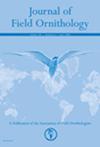Seasonal drivers of mixed-species flocks from tropical savannas: insights from the Pantanal wetland
IF 0.9
4区 生物学
Q3 ORNITHOLOGY
引用次数: 0
Abstract
. Birds participate in different types of multi-species groups (e.g., mixed-species flocks) occurring from temperate to tropical forest and also savannas. However, the effects of seasonal variation in flocking dynamics and formation in tropical savannas, especially in seasonally flooded wetlands, have received comparatively less attention than tropical forests and temperate ecosystems. Because multi-species groups can reflect specific aspects of the bird community (e.g., temporal dynamics), the present study aims to describe the structure, organization, and seasonal variation of mixed-species flocks in the Pantanal, the world’s largest tropical wetland. During the dry, flood, and rainy seasons of 2019 and the flood season of 2020, we observed flocks within the natural mosaic of grassy-shrubby vegetation and patchy forest, and recorded the number of species, individuals (per species), and diversity. Seasonality had a strong influence on flocking structure and organization. During the rainy season, flocks had significantly fewer species, individuals, and diversity, whereas during the dry and flood seasons, flocks had more species, individuals, and diversity. Moreover, we suggest Polioptila dumicola and Casiornis rufus to act, respectively, as the nuclear and the sentinel species of flocks. These species were present in flocks during the year, but they were less frequent during the rainy season. The breeding period during the rainy season may negatively influence the formation of mixed-species flocks, whereas the access to food resources and predator protection may instead facilitate their formation in the dry and flood seasons, respectively. Our results help fill a knowledge gap on how mutualistic interactions among bird species are organized and vary in seasonal and heterogeneous environments热带稀树草原混合物种群的季节性驱动因素:潘塔纳尔湿地的见解
。从温带到热带森林和稀树草原,鸟类参与不同类型的多物种群体(例如,混合物种群)。然而,与热带森林和温带生态系统相比,季节变化对热带稀树草原,特别是季节性淹没湿地的群落动态和形成的影响受到的关注相对较少。由于多物种群可以反映鸟类群落的特定方面(如时间动态),本研究旨在描述潘塔纳尔湿地(世界上最大的热带湿地)中混合物种群的结构、组织和季节变化。在2019年旱季、汛期、雨季和2020年汛期,我们在草灌丛植被和斑片森林的天然马赛克中观察了鸟群,记录了物种数量、个体数(每物种)和多样性。季节性对群落结构和组织有重要影响。在雨季,禽群的种数、个体数和多样性均显著减少,而在旱季和汛期,禽群的种数、个体数和多样性均显著增加。此外,我们认为白脊灰蝶(Polioptila dumicola)和鲁弗斯卡西欧尼(Casiornis rufus)分别是群中的核种和哨种。这些物种在一年中成群出现,但在雨季较少出现。雨季的繁殖期可能会对混合种群的形成产生负面影响,而在旱季和汛期,食物资源的获取和捕食者的保护可能会促进混合种群的形成。我们的研究结果有助于填补鸟类物种之间的相互作用是如何在季节性和异质环境中组织和变化的知识空白
本文章由计算机程序翻译,如有差异,请以英文原文为准。
求助全文
约1分钟内获得全文
求助全文
来源期刊

Journal of Field Ornithology
生物-鸟类学
CiteScore
1.40
自引率
0.00%
发文量
22
审稿时长
3 months
期刊介绍:
The Journal of Field Ornithology welcomes original articles that emphasize the descriptive or experimental study of birds in their natural habitats. Articles depicting general techniques, emphasizing conservation, describing life history, or assessing published studies or existing ideas are appropriate. The Journal is especially interested in field studies conducted in the Neotropics and those involving participation by nonprofessional ornithologists.
 求助内容:
求助内容: 应助结果提醒方式:
应助结果提醒方式:


